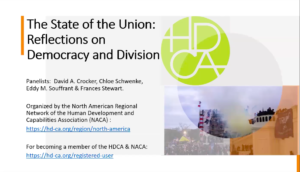…e supremacy, and toxic masculinity. These forces converged in a literal attack on democracy during an insurrection at the Capitol building in Washington, DC on January 6, 2021. More globally, a recent “democratic recession” seems to have halted if not reversed the third wave of democratization (Diamond 2015), and everywhere there are signs of the deterioration of political rights and civil liberties (Abramowitz 2018), the erosion of citizens’ trus…
HDCA Webinar North American Network HDCA VideosThe State of the Union: Reflections on Democracy and Division in and beyond the United States of America

